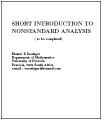Mathematical Methods for Economic Theory: a tutorial
by Martin J. Osborne
Publisher: University of Toronto 2007
Number of pages: 301
Description:
This tutorial covers the basic mathematical tools used in economic theory. Knowledge of elementary calculus is assumed; some of the prerequisite material is reviewed in the first section. The main topics are multivariate calculus, concavity and convexity, optimization theory, differential equations, and difference equations. The emphasis throughout is on techniques rather than abstract theory.
Download or read it online for free here:
Read online
(online html)
Similar books
 Elementary Mathematical Analysis
Elementary Mathematical Analysisby J.W. Young, F.M. Morgan - The Macmillan Company
The book presents a course suitable for students in the first year of our colleges, universities, and technical schools. It presupposes on the part of the student only the usual minimum entrance requirements in elementary algebra and plane geometry.
(12046 views)
 Special Functions and Their Symmetries: Postgraduate Course in Applied Analysis
Special Functions and Their Symmetries: Postgraduate Course in Applied Analysisby Vadim Kuznetsov, Vladimir Kisil - University of Leeds
This text presents fundamentals of special functions theory and its applications in partial differential equations of mathematical physics. The course covers topics in harmonic, classical and functional analysis, and combinatorics.
(16001 views)
 Short introduction to Nonstandard Analysis
Short introduction to Nonstandard Analysisby E. E. Rosinger - arXiv
These notes offer a short and rigorous introduction to Nostandard Analysis, mainly aimed to reach to a presentation of the basics of Loeb integration, and in particular, Loeb measures. The Abraham Robinson version of Nostandard Analysis is pursued.
(13130 views)
 An Introduction to Asymptotic Analysis
An Introduction to Asymptotic Analysisby Simon J.A. Malham - Heriot-Watt University
From the table of contents: Order notation; Perturbation methods; Asymptotic series; Laplace integrals (Laplace's method, Watson's lemma); Method of stationary phase; Method of steepest descents; Bibliography; Notes; Exam formula sheet; etc.
(7495 views)